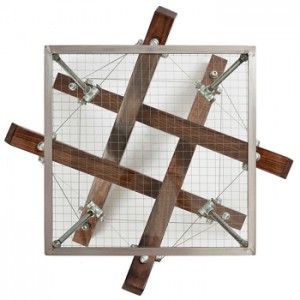Over the last 10 days or so, I’ve stumbled across two references to Archimedes in my constant search for information on nanotechnology. Not remembering my ancient Greeks very well, I found this about him on Wikipedia (Note: Links and footnotes have been removed),
Archimedes of Syracuse (Greek: Ἀρχιμήδης; c. 287 BC – c. 212 BC) was a Greek mathematician, physicist, engineer, inventor, and astronomer. Although few details of his life are known, he is regarded as one of the leading scientists in classical antiquity. Among his advances in physics are the foundations of hydrostatics, statics and an explanation of the principle of the lever. He is credited with designing innovative machines, including siege engines and the screw pump that bears his name. Modern experiments have tested claims that Archimedes designed machines capable of lifting attacking ships out of the water and setting ships on fire using an array of mirrors.
Archimedes is generally considered to be the greatest mathematician of antiquity and one of the greatest of all time.
His influence lives on as he’s referenced in an Aug. 15, 2013 news item on Nanowerk concerning graphene nanoscrolls,
Researchers at Umeå University, together with researchers at Uppsala University and Stockholm University, show in a new study how nitrogen doped graphene can be rolled into perfect Archimedean nano scrolls by adhering magnetic iron oxide nanoparticles on the surface of the graphene sheets. The new material may have very good properties for application as electrodes in for example Li-ion batteries.
The Aug. 15, 2013 Umeå University press release,which originated the news item, provides technical details,
In the study the researchers have modified the graphene by replacing some of the carbon atoms by nitrogen atoms. By this method they obtain anchoring sites for the iron oxide nanoparticles that are decorated onto the graphene sheets in a solution process. In the decoration process one can control the type of iron oxide nanoparticles that are formed on the graphene surface, so that they either form so called hematite (the reddish form of iron oxide that often is found in nature) or maghemite, a less stable and more magnetic form of iron oxide.
“Interestingly we observed that when the graphene is decorated by maghemite, the graphene sheets spontaneously start to roll into perfect Archimedean nano scrolls, while when decorated by the less magnetic hematite nanoparticles the graphene remain as open sheets, says Thomas Wågberg, Senior lecturer at the Department of Physics at Umeå University.
The nanoscrolls can be visualized as traditional “Swiss rolls” where the sponge-cake represents the graphene, and the creamy filling is the iron oxide nanoparticles. The graphene nanoscrolls are however around one million times thinner.
The results that now have been published in Nature Communications are conceptually interesting for several reasons. It shows that the magnetic interaction between the iron oxide nanoparticles is one of the main effects behind the scroll formation. It also shows that the nitrogen defects in the graphene lattice are necessary for both stabilizing a sufficiently high number of maghemite nanoparticles, and also responsible for “buckling” the graphene sheets and thereby lowering the formation energy of the nanoscrolls.
The process is extraordinary efficient. Almost 100 percent of the graphene sheets are scrolled. After the decoration with maghemite particles the research team could not find any open graphene sheets.
Moreover, they showed that by removing the iron oxide nanoparticles by acid treatment the nanoscrolls again open up and go back to single graphene sheets
The researchers have an image showing a partially reopened scroll (despite references to Archimedes and swiss rolls, I see a plant leaf or flower unfurling),
![Caption: Snapshot of a partially re-opened nanoscroll. The atomic layer thick graphene resembles a thin foil with some few wrinkles. [Courtesy of Umeå University]](http://www.frogheart.ca/wp-content/uploads/2013/08/NanoscrollPartiallyReopened.jpg)
Caption: Snapshot of a partially re-opened nanoscroll. The atomic layer thick graphene resembles a thin foil with some few wrinkles. [Courtesy of Umeå University]
Tiva Sharifi, Eduardo Gracia-Espino, Hamid Reza Barzegar, Xueen Jia, Florian Nitze, Guangzhi Hu, Per Nordblad, Cheuk-Wai Tai, and Thomas Wågberg: Formation of nitrogen-doped graphene nanoscrolls by adsorption of magnetic γ-Fe2O3 nanoparticles, Nature Communications (2013), DOI:10.1038/ncomms3319.
The article is behind a paywall.
The other Archimedes reference is regarding a new website, nano-archimedes, mentioned in an Aug. 10, 2013 news item on Nanowerk,
Nano-archimedes is a Technology Computer Aided Design tool (TCAD) for the simulation of electron transport in nanometer scale semiconductor devices (nanodevices). It is based on the Wigner equation, a convenient reformulation of the Schrödinger equation in terms of a phase-space, which allows the application of stochastic particles methods and the extension towards mixed state kinetic descriptions such as the Wigner-Boltzmann equation.
There’s more on the nano-archimedes homepage,
It is an experimental code for validation and analysis of the compatibility of existing quantum particle concepts in algorithmic schemes. Our preliminary results have clearly shown that time-dependent, full quantum and multi-dimensional simulations of electron transport can be achieved with no special computational requirements. The code is already able to simulate time dependent phenomena such as two-dimensional wave phase breaking and single electron ballistic transport with open boundary conditions aiming to have, very soon, full quantum self-consistent calculations for nanodevices.
nano-archimedes runs both on serial and parallel machines and the parallelization scheme is based on OpenMP – a standard library for parallel calculations. The code is entirely written in C and can compile on a huge variety of machines without any particular effort. The only external dependence is OpenMP, everything else is embedded in the code to make it truly cross-platform.
I found the background of the team members behind this effort rather interesting, from the Team page,
Main developer and principal maintainer of the code:
Jean Michel Sellier, IICT, Bulgarian Academy of Sciences, Bulgaria, supported by the AComIn project.Main developer, theory and physical analysis:
Mihail Nedjalkov, Institute for Microelectronics, TU Wien, Austria.Advisory board:
Ivan Dimov, Bulgarian Academy of Sciences, Bulgaria.
Siegfried Selberherr, Institute for Microelectronics, TU Wien, Austria.Website Master:
Marc Sellier, working at Selliweb, Italy.
I don’t often have a chance to mention Bulgaria and I expect that’s due to the fact that my linguistic skills are largely English with a little French flavour thrown into the mix. The consequence is that I’m confined and while I realize English is the dominant language in science there’s still a lot of scientific materials that never finds its way into English and I don’t trust machine translations.

